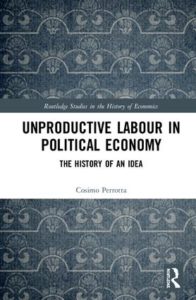Unproductive Labour in Political Economy
The History of an Idea
By Cosimo Perrotta
Routledge, 2018
270 pages
Contemporary mainstream economists see social wealth as the sum of individual incomes, but for three centuries many economists saw wealth as consisting of the public and private resources of a nation. This led them to explore the idea of unproductive labour, which provides a nation with an individual income, but does not contribute to an increase in social wealth or help to foster development.
This book analyses the evolution of ideas surrounding unproductive labour, offering an unprecedented history that guides readers from the work of Petty through to the present economic crisis. This volume explores the work of several key scholars, including Smith, Petty, Marx, Ricardo, Mill, Say and Schumpeter.
This book is suitable for scholars and researchers with an interest in the history of economic thought, labour economics and economic philosophy.
I – Introduction: what is unproductive labour,
II – Unproductive labour before Smith,
III – Physiocracy: labour productive of surplus – Condillac,
IV – Adam Smith: the struggle against rent,
V – Supporters of Smith on unproductive labour,
VI – Critics of Smith on services and intellectual labour,
VII – The subjective approach (all labour productive),
VIII – The deadlock of unproductive consumption,
X – Underconsumption and crises,
X – Technical progress,
XI – Marx’s blind alley on unproductive labour,
XII – Investment in human capital,
XIII – Overproduction versus underconsumption,
XIV – Fall and revival of Smith’s distinction,
XV – Crises and underconsumption in Marx and his followers,
XVI – Productiveness of public expenditures,
XVII – Productive labour in the 1960s-70s Marxist thought,
XVIII – New middle classes and human capital,
XIX – The welfare state as investment in human capital,
XX – Saturation: the growth of unproductive labour,
XXI – The future of productive labour.
Visit the book’s page on Routledge.com
